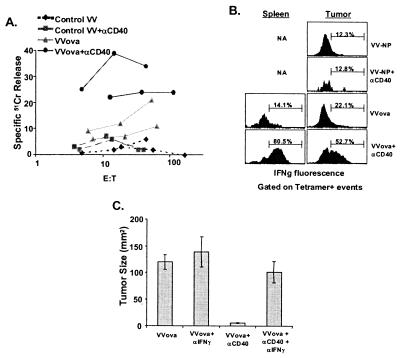Figure 4.
VVova and anti-CD40 treatment results in enhanced lytic activity and IFNγ production from tumor-specific CD8+ T cells. Mice were challenged with tumor and treated with VVova and/or anti-CD40 as in Fig. 3. (A) Twenty-five days after initial tumor challenge, spleens were removed from the different treated groups and restimulated with 5 μg/ml ovalbumin peptide in vitro for 5 days. The cells were washed, and 51Cr release lytic assays were performed as described in Materials and Methods. Cells from two mice per treatment group are shown and are representative of two separate experiments performed. (B) Twenty-five days after initial tumor challenge, spleen and tumor tissue were removed from the different groups, and the cells were stained and analyzed for the expression of intracellular IFNγ in tetramer-staining cells as described for Fig. 2. The results are representative of four independent experiments. (C) Blocking IFNγ in VVova + anti-CD40-treated tumor-bearing mice eliminates the inhibition of tumor growth normally seen with this treatment. Tumor-bearing mice were treated with anti-CD40 and/or VVova as in Fig. 3. Seven days after VVova immunization, mice were injected with 3 mg of XMG1.2 (anti-IFNγ) or control anti-DR4 i.p. every 7 days. Twenty-five days after initial tumor challenge, tumors from two to three mice per group were measured by caliper. The error bars indicate the standard error of tumor size within a given treatment group. The data are representative of three experiments performed.

